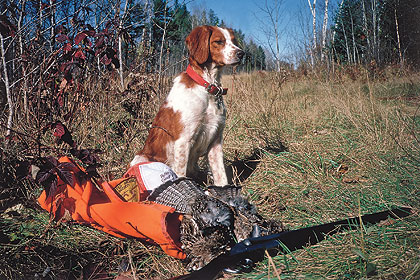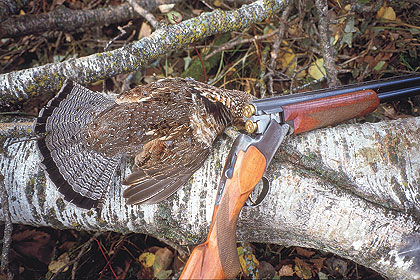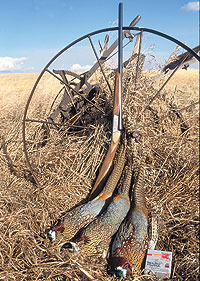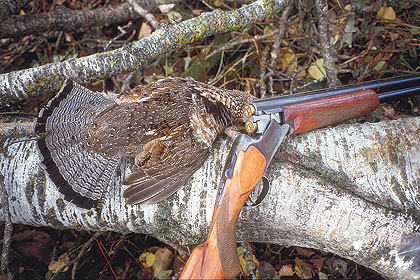By Joel Vance
The mind is a sloppy monitor, kind of like watching television through a bowl of Jell-O.
 When photographing your gun dog, have someone attract the dog's attention so the dog is looking to one side of the cameras with ears alert. |
Better to photograph precious memories so you know how they really looked.
But who wants to lug a camera into the field to get in the way? Not to worry -- today's digital pocket cameras are versatile and unobtrusive.
"Point-and-shoot" cameras, made by Nikon, Yashica, Ricoh, Canon, Olympus, Minolta, Leica and others range in price from $100 to $300 or so. They usually have either a fixed lens or a zoom arrangement. They fit in a pocket and always are handy.
A regular 35 mm camera with a 35-80 mm zoom lens is far more versatile, but also bulkier. Store that in an inexpensive fanny pack along with extra lenses until needed.
Figure on an interchangeable lens camera body costing at least $300-$1,000, lens a minimum of $300 more. Autofocus cameras think for you, but some won't work in really cold temperatures. Always carry spare batteries and if you can buy them at camera stores (they're fresher than discount house batteries. Or use rechargeable batteries (and remember the charger on out-of-town trips).
The day of slides or prints has gone -- everything is digital and with a good editing program (think Photoshop Elements or, even better, Lightroom) you can turn mediocre photos into pretty good ones, especially by judicious cropping, jiggering contrast and brightness.
Take time to compose photos...later you'll find them to be far more interesting than random snapshots. Take mood shots of your buddies smoking their pipes or carving rat cheese at a rest break (or sprawled out with the dog). Use a small flash or the camera's built-in flash on sunny days to fill shadowed areas with light, especially faces shadowed by cap brims (and have the subjects tilt their caps back and take off their dark-lensed glasses).
 Get close to your subjects for added impact. |
Be aware of background distractions, like power lines or the smart alec giving you the finger.
Pose a nice-looking grouse or pheasant or woodcock with your gun on a lichen-covered rock or old log. If you can get your dog to sit by it, so much the better. Have your buddies photograph you with your dog, gun and bag.
Shoot low angle or high angle. Frame the shot through a branch of autumn-tinged leaves.
Think vertically as well as horizontally for artistic effect.
Think in terms of a "story." Photograph hunt preparations, the dogs starting out, scenic shots down a woodland corridor or through fall-tinged leaves, the rest break, the end of the day with the bag. Tired dogs are a good subject. If they're covered with weed seeds (the so-called "sticktights") it makes a good shot. Get close-ups of dogs drinking thirstily or being de-burred. If you can get a dog to pose holding a bird, shoot just head and shoulders and have someone attract the dog's attention so it is looking to one side of the camera with ears alert.
Among my favorite dog photos is a family snapshot of a long-ago setter locked on point€¦at a hunter's sandwich during the lunch break.
Get closer to your subjects: head shots, torsos, closeups of guns, gloves. This is what professionals do -- maybe just a hand carrying a pheasant or grouse.
Those priceless moments that never will come again? They do if you photograph them.
 Priceless moments can live on in a photograph. |
I hope I'm wrong, but I have the uncomfortable feeling that there aren't any legends in the making anymore. Thus it is saddening when one of the existing ones has gone. The latest is Andy Ammann -- more formally Dr. George Andrew Ammann, Sr.
He was perhaps the country's leading authority on woodcock and was 98 when he died. I have a vivid memory of many years ago when he came to Missouri to band woodcock and I went along with him to photograph both him and the birds (and the lovely setter he used to locate brooding hens).
Dolly the setter pinned a hen with chicks and Andy carefully searched the ground until he spotted the nearly invisible bird, then he trapped it and the two chicks with a butterfly net and banded them.
I was honored a few weeks later when Andy asked if he could use one of my photos as the cover shot on a booklet on woodcock. The booklet is a cherished possession.
Later we ran into Charley Schwartz and as they chatted I realized, dimly at the time, but much more so now, that I was seeing two legends in the flesh. Charley was the illustrator for Aldo Leopold's A Sand County Almanac and a true renaissance genius. He was an artist, sculptor, moviemaker, photographer and legendary prairie chicken biologist.
And he was a role model, friend and mentor for and to me. He lived to 78, but retained a lifelong kid's enthusiasm for everything. Writer John Madson once described Charley as "Sixty years old, going on 15."
 Scenic shots are great storytellers. |
There was a special quality to the early wildlifers because they were inventing a profession. I don't mean to be critical of today's biologists, but it seems as if some of the creativity of the early years has given way to computer modeling and cookie cutter research.
"They don't," said a long-time friend, "have mud on their boots." Only he didn't say "mud."
The pioneers didn't have computers. They only ha
d their eyes. The only time clock they worked from was the one on their wrist and it often ran 24 hours a day. They didn't merely repeat what had been done before because it hadn't. They improvised and experimented and gradually came to understand their target animals as no one had before.
Since then I've seen modern researchers cover the same ground as their pioneer forebears, using computer models, radio telemetry, and all the tools of today€¦only to come up with exactly the same conclusions as the original.
Again, that's not to run down what is happening today and not to conclude that there will be no legends from today's crop of researchers and management biologists. If it sometimes seems like we're reinventing the wheel, perhaps we should think of it as reinforcing the wheel...and give a tip of the hat to the guys who invented the wheel in the first place.
Joel Vance is the author of Grandma and the Buck Deer (softcover $15); Bobs, Brush and Brittanies (hardcover $25); Down Home Missouri (hardcover $25); and Autumn Shadows limited edition, signed $45). Available from Cedar Glade Press, Box 1664, Jefferson City MO 65102. Add $2/book for S/H.






